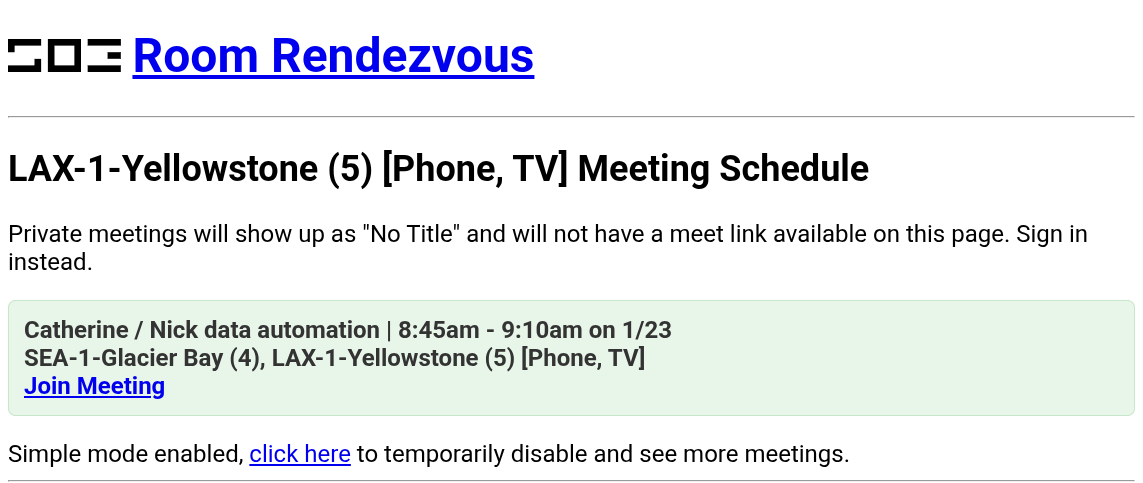Sometimes, a problem at work is just too satisfying not to solve over a weekend with ChatGPT and a straightforward Google API.
Problem Statement
At SOE, the lack of teleconferencing systems designed for seamless meeting room experiences has always been a challenge. Joining teleconferencing meetings required manually logging into conference room computers—a process that was slow and often delayed meetings, especially when two-factor authentication (2FA) was involved. Each meeting could lose valuable time as entire groups waited for a single person to sign in.
For years, I’d been brainstorming ways to make this process faster. One weekend, after incorporating ChatGPT into my coding workflow, I decided to tackle the issue head-on.
Solution Summary
The solution is refreshingly simple. A Flask server runs with all of our conference room Google Calendar objects preloaded. Each room has a bookmark to its specific page, which provides direct links to that room’s scheduled meetings. When loaded, users can request to join directly from the page.
For security, someone still needs to be signed in somewhere, but it’s usually straightforward—most users have a laptop or phone already logged in without needing 2FA. By signing in with Companion Mode, users can let the meeting room in and save valuable minutes for every meeting. Alternatively, someone attending remotely can grant access.
I had a working demo by the end of the weekend, deployed it in a test conference room on my personal Linux machine, and began early trials.
Adoption and Team Feedback
I’ve never experienced such immediate, positive feedback on a deployment. The initial rollout included constructive suggestions for quality-of-life improvements, but after just a few iterations, I moved the service to company infrastructure and deployed it across all conference rooms. It’s been running for months with no maintenance required—proving the effectiveness of a “Keep It Simple, Stupid” (KISS) approach.
There’s a list of future enhancements, like scraping descriptions for Zoom or Teams links, but for now, this solution covers 90% of meeting scenarios and has been remarkably robust.
While larger conference rooms are slowly transitioning to proper teleconferencing equipment, I suspect this script will remain useful for quite some time.
As for the impact? Saying it “saves $30k a month” is a bit generous—it’s more accurate to say it “recovers $30k of value monthly” based on meeting time analysis I ran with another script. That said, the effect on efficiency has been significant.
Aside on Generative AI
Generative AI turned out to be incredibly intuitive to use. My experience using it for side projects has been excellent, but like any tool, it has its limits. I find the following quote from “Generative AI is not going to build your engineering team for you” captures it perfectly:
[Generative AI is] an excitable junior engineer who types really fast
This matches my experience—it doesn’t always work, occasionally hallucinates, and sometimes produces solutions that don’t fit. But more often, it’s a force multiplier. With proper guidance and feedback (much like mentoring a junior engineer), I’ve been able to make far more progress than I would coding alone.
I certainly don’t rely on modern AI tool’s first order outputs on their own, and share the following rules with my team when they approach these tools:
GenAI Rules
- You are 100% responsible for all of the output
- Don’t input proprietary customer information into the tool
